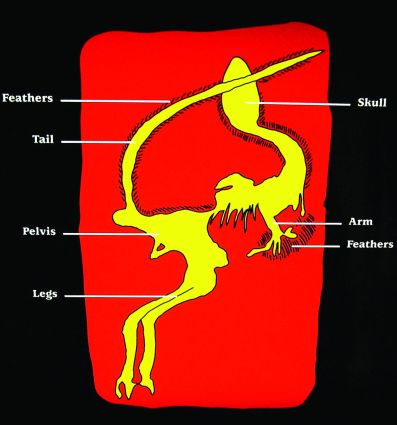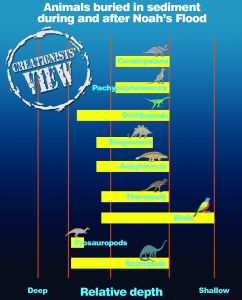Dinosaur fairy tales
Remove the hype and discover a different story about the dinosaur family tree


Giant Chinese dinosaurs have been touring Australia after appearances in Japan and New Zealand. No, it’s not Jurassic Park. It is an exhibition featuring many well-preserved dinosaur skeletons, like the massive 23-metre sauropod Mamenchisaurus, with its 9-metre-long neck.1
The exhibit, called Chinese Dinosaurs, also includes fossils of dinosaur eggs, claws and teeth, as well as marine reptiles such as plesiosaurs and turtles. It is truly an awe-inspiring display.
Naturally, fossils cannot speak for themselves. Instead, people interpret fossils according to their beliefs. It is clear that the organizers believe that life evolved on Earth over millions of years because they provide copious signs, labels, lectures, videos and books to encourage visitors to interpret the fossils this way.
One particular diagram that vividly makes this point is a dinosaur ‘family tree’, which they placed prominently alongside every exhibit.1
According to this diagram (see figure 1), all dinosaurs (and birds) descended from a common dinosaurian ancestor that lived some 240 million years ago, during the early Triassic period. The diagram clearly shows the ancestor-descendent relationships leading from this single ancestor to each of the different kinds of dinosaurs.
For example, the diagram suggests that the group of ceratopsian dinosaurs at the top are directly related to the group immediately underneath, the pachycephalosaurs. The diagram indicates that the two groups separated from a common ancestor that lived about 140 million years ago (during the early Cretaceous period). Furthermore, both of these groups of dinosaurs are supposedly related to the next group, called the ornithopods. They allegedly separated from their common ancestor about 200 million years ago (during the early Jurassic period).
Most people would not realize that this dinosaur family tree does not present observed scientific fact. Rather, it presents assumptions, hypotheses and beliefs as if they are observed facts. Biologist Jonathan Wells claims such diagrams misrepresent the truth and calls them ‘icons’—symbols of an idea—not factual evidence.2 Let’s see why.
First, no evidence exists for any of the common ancestors indicated on the diagram. At Chinese Dinosaurs, the position of each fossil animal on the family tree is marked on an adjacent sign. Every fossil sits on one of the branches of the tree (the thick, horizontal lines). The exhibition does not present one example of the supposed common ancestors required by its own diagram. That’s because evidence for these common ancestors does not exist.
Then, the dates on the diagram (from 65 million to 245 million years) are not scientifically measured facts. It’s obvious that when palaeontologists dig up dinosaur bones, they do not find a label attached with the age written on it. The dates are interpretations based on conjectures designed to give results consistent with evolutionary beliefs. Both radiometric dating and index fossil comparisons are based on assumptions about the past—assumptions that cannot be tested in the present.
So, to present the actual scientific evidence (rather than evolutionary beliefs) on the diagram, we would remove all the hypothetical common ancestors and the imaginary family links. We would also remove the ages of millions of years. Instead of ‘millions of years ago’, we would write something like ‘relative depth’. At the ‘245-million-year’ end we would put ‘deep’ and at the ‘65-million-year’ end we would put ‘shallow’.
Thus, if we amended the diagram to represent the evidence based on the facts, it would no longer look like a family tree (see diagram left).

At face value, what does the evidence at the Chinese Dinosaurs exhibition point toward? Firstly, there are all sorts of different animals buried in sedimentary rock layers. They include land animals (dinosaurs), marine animals (plesiosaurs), and birds (such as Archaeopteryx). The huge animals were buried at different depths in sediment, which was laid down by water.
Furthermore, the sediment covered their bodies quickly, before they rotted away or could be scavenged.
In addition, fossils of the different kinds of animals appear suddenly in the strata and don’t change much from the deepest to the shallowest rocks. In other words, there is no clue that any kind of animal evolved from a different kind of ancestor, or that any kind of animals evolved into other kinds after they first appeared in the deepest rocks.
So when we clear away the evolutionary story telling, we can see that a different story fits the evidence better. The evidence is consistent with biblical history, that different kinds of animals were created suddenly at the beginning during Creation Week, and that they reproduced after their kind. The fossil deposits are best explained by the global Flood of Noah—the catastrophe that devastated the land, the sea and the atmosphere about 4,500 years ago.3

|

|
References
- Lavarack, J.W. (Ed.), Chinese Dinosaurs: Dragon Bones & Dragon Birds; in: Riversleigh Notes, Issue No. 53, 2nd ed., The Riversleigh Society and The Australian Museum, 2003. Return to text.
- See, Wells, J., Icons of Evolution, science or myth?: Why much of what we teach about evolution is wrong, Regnery Publishing Inc., Washington D.C., 2000. Return to text.
- For the true history of dinosaurs, see Ham, K., The Great Dinosaur Mystery Solved! Master Books, Arkansas, USA, 2000; or access Chinese Dinosaurs. Return to text.








Readers’ comments
Comments are automatically closed 14 days after publication.